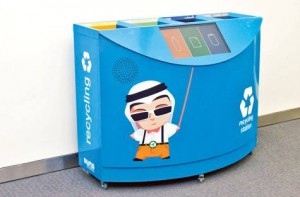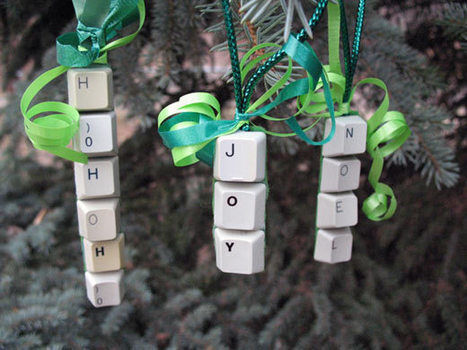
Image Credit: Masdar Institute of Science and Technology
Would you like to know the impact your recycling efforts are having every time you pop a drinks can or plastic bottle into a recycling waste bin? Well now you can! A collaboration between an Abu Dhabi company and the Masdar Institute of Science and Technology has come up with an ingenious interactive waste bin. Every time you make a deposit you are told of the positive impact your waste item has had. The waste bin has separate compartments for paper, metal, plastic and general waste. So far it is only a prototype but we hope the idea will catch on and you might find them on your local high street in the very near future.
Some of the messages you can expect to hear include:
-
Recycling one plastic bottle saves enough energy to run a fridge for over 2 hours
-
By recycling a plastic bottle you are saving over 10 litres of water
-
Recycling one aluminium can saves enough energy to power a laptop for almost an hour
-
A tonne of recycled paper saves 17 trees
-
Plastic can last up to 1,000 years in landfill
These are only a few examples of the messages that can be conveyed by the interactive waste bin. The messages can actually be customised to the particular needs of the location. For example a bin located on school premises could convey information relevant to young children. Whereas the messages for a bin located in a busy factory would need to be very different. Many more electronic features can be added including real time alerts on the amount of space left and quantity waiting to be collected. Either via Twitter or email to the collection company.
If the bins are placed in locations such as institutions, schools or company premises they can be linked via the internet enabling the type and quantity of waste collected to be tracked. Thereby allowing waste campaigns to be tailored to a particular locations needs. We think this is all pretty useful information as it promotes action on a personal level without actually telling people what to do.
In New York there is another twist on the traditional receptacle popping up to assist in encouraging recycling and making the process quicker and simpler. The recycling receptacle is able to compact the waste automatically and alert the collection company when it needs emptying and in addition it is solar powered.

 This particular talk highlighted the plight of Brazil’s “catadores”, but has equal relevance for many other countries both in the developing and developed world. They collect junk and recyclables, removing it from the city streets and taking it to places where it can be recycled. Amazingly 90% of Brazil’s recyclable waste is collected by these superheroes.
This particular talk highlighted the plight of Brazil’s “catadores”, but has equal relevance for many other countries both in the developing and developed world. They collect junk and recyclables, removing it from the city streets and taking it to places where it can be recycled. Amazingly 90% of Brazil’s recyclable waste is collected by these superheroes. Here at Rubbish Please we’ve been reading a new report written by WRAP (Waste and Resources Action Programme) which assesses how food waste levels have changed over recent years and how these can be influenced in the future. We thought you might be interested in some of the information so we’ve decided to share them with you in our blog.
Here at Rubbish Please we’ve been reading a new report written by WRAP (Waste and Resources Action Programme) which assesses how food waste levels have changed over recent years and how these can be influenced in the future. We thought you might be interested in some of the information so we’ve decided to share them with you in our blog. 2015 is now well under way and new waste regulations mean there must be a “separate collection” of paper, plastic, metals and glass for recycling. These changes have been introduced to reduce contamination and increase the quality of recycled materials. Good quality recycled materials have a high value whereas poor quality equates to low value, bad odours, health hazards and a high risk of fire.
2015 is now well under way and new waste regulations mean there must be a “separate collection” of paper, plastic, metals and glass for recycling. These changes have been introduced to reduce contamination and increase the quality of recycled materials. Good quality recycled materials have a high value whereas poor quality equates to low value, bad odours, health hazards and a high risk of fire. Annual targets for recycling are constantly changing but it appears that household recycling has barely changed in recent years. Last year there was little change from 2012 and experts say that it’s due in part to the fact that consumers are using less paper. Which in turn means that there is in fact less to recycle. The switch to online reading and the purchase of products that use less packaging mean it looks increasingly unlikely that we’ll meet the targets set in Brussels. The current target is for UK recycling rates to hit 50% by 2020 and failing to meet them could mean we face fines of more than £500,000 per day, if estimates are right.
Annual targets for recycling are constantly changing but it appears that household recycling has barely changed in recent years. Last year there was little change from 2012 and experts say that it’s due in part to the fact that consumers are using less paper. Which in turn means that there is in fact less to recycle. The switch to online reading and the purchase of products that use less packaging mean it looks increasingly unlikely that we’ll meet the targets set in Brussels. The current target is for UK recycling rates to hit 50% by 2020 and failing to meet them could mean we face fines of more than £500,000 per day, if estimates are right. When you’re buying a new gadget for your loved one this Christmas spare a thought for the item it’ll be replacing and what’s going to happen to it when it’s no longer needed. In 2011 nearly 42 million tonnes of electronic waste was generated, a figure that is set to increase to almost 100 million tonnes by 2016. And the sad fact is that the gadgets that are being upgraded or replaced usually end up in landfill rather than properly recycled. But it’s not just consumers who need to be aware of the waste they are creating. Manufacturers also need to think about recycling and not only in the manufacturing plants. Sure many of the top companies are introducing green initiatives that involve using greener energy, reducing packaging and designing products that use less power. But they must also be responsible for the products that consumers no longer use.
When you’re buying a new gadget for your loved one this Christmas spare a thought for the item it’ll be replacing and what’s going to happen to it when it’s no longer needed. In 2011 nearly 42 million tonnes of electronic waste was generated, a figure that is set to increase to almost 100 million tonnes by 2016. And the sad fact is that the gadgets that are being upgraded or replaced usually end up in landfill rather than properly recycled. But it’s not just consumers who need to be aware of the waste they are creating. Manufacturers also need to think about recycling and not only in the manufacturing plants. Sure many of the top companies are introducing green initiatives that involve using greener energy, reducing packaging and designing products that use less power. But they must also be responsible for the products that consumers no longer use.
 Christmas Shouldn’t be all About Spending Money – Spare a Thought for the Environment too!
Christmas Shouldn’t be all About Spending Money – Spare a Thought for the Environment too!








